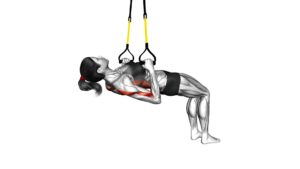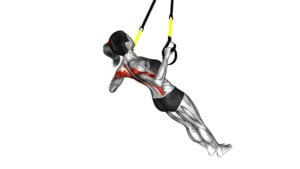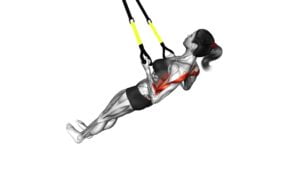Suspender Inverted Row (female) – Video Exercise Guide & Tips

Are you looking for a challenging upper body exercise that targets your back muscles? Look no further than the Suspender Inverted Row.
Watch This Exercise Video
This video exercise guide and tips article will show you how to perform this exercise correctly for maximum results.
Whether you're a beginner or advanced, you'll find variations and modifications to suit your fitness level.
Get ready to take your workout to new heights with this effective exercise.
Key Takeaways
- The Suspender Inverted Row targets multiple muscle groups simultaneously, including the back, shoulders, and arms.
- It improves overall upper body strength and stability, utilizing body weight as resistance.
- Proper form and technique are important to avoid common mistakes such as using momentum and neglecting full range of motion.
- Advanced variations and modifications, such as single-arm suspender inverted row and weighted suspender inverted row, can be incorporated to challenge and progress the exercise.
Benefits of the Suspender Inverted Row
One of the main benefits of the Suspender Inverted Row is that it allows you to target multiple muscle groups simultaneously. This exercise is highly effective in activating the muscles in your back, shoulders, and arms. By pulling yourself up using the suspended straps, you engage muscles such as the latissimus dorsi, rhomboids, trapezius, and biceps. This comprehensive muscle activation helps to improve your overall upper body strength and stability.
When compared to other back exercises, the Suspender Inverted Row offers unique advantages. Unlike traditional rowing exercises that require equipment like dumbbells or barbells, the Suspender Inverted Row utilizes your body weight as resistance. This makes it a convenient and cost-effective option for those who may not have access to a gym or equipment. Additionally, the suspended straps allow for a greater range of motion, enabling you to fully engage your muscles throughout the exercise.
Equipment Needed for the Exercise
To perform the Suspender Inverted Row, you'll need a few pieces of equipment. Here is a list of what you'll need:
- Suspenders: The main equipment needed for this exercise is a pair of suspenders. Suspenders come in various types, such as adjustable suspenders, clip-on suspenders, and button-on suspenders. Choose the type that suits your preference and provides a secure fit.
- Suspension Trainer: In addition to suspenders, you'll also need a suspension trainer. This equipment consists of adjustable straps that can be attached to a sturdy anchor point, such as a door frame or a bar. The suspension trainer will provide the necessary stability and support during the exercise.
Alternative Options:
- Resistance Bands: If you don't have access to suspenders or a suspension trainer, you can use resistance bands as an alternative. Simply attach the bands to a secure anchor point and hold onto the handles while performing the exercise. Make sure the resistance bands are strong enough to support your body weight.
- TRX Straps: Another alternative to suspenders is using TRX straps. These straps are specifically designed for suspension training and provide a stable platform for performing exercises like the Suspender Inverted Row.
Proper Form and Technique for Beginners
To ensure proper form and technique as a beginner, there are a few common mistakes you should avoid. These include:
- Using momentum to perform the exercise
- Not engaging your core
- Allowing your shoulders to shrug or hunch up
It's important to focus on maintaining control and proper alignment throughout the movement.
As you progress and become more advanced, you can also explore different variations and progressions of the suspender inverted row to continue challenging your muscles.
Common Mistakes to Avoid
When performing the Suspender Inverted Row, ensure proper form and technique by avoiding these common mistakes:
- Using momentum: Avoid using momentum to swing your body up and down during the exercise. This not only reduces the effectiveness of the workout but also increases the risk of injury.
- Neglecting full range of motion: Make sure to pull yourself up until your chest touches the bar and lower yourself down until your arms are fully extended. Failing to complete the full range of motion can limit the benefits of the exercise.
Progression for Advanced Users
Are you ready to take your Suspender Inverted Row workout to the next level with advanced progression techniques? If you're an advanced user looking for a challenge, there are several advanced progressions and challenging variations you can try.
One option is to increase the difficulty by elevating your feet on a bench or stability ball. This will engage your core and upper body even more.
Another option is to add weight to your inverted row by wearing a weighted vest or holding dumbbells. This will help to build strength and muscle.
Additionally, you can experiment with different grip variations, such as using a wide grip or a narrow grip, to target different areas of your back and arms.
Remember to always maintain proper form and technique to maximize the effectiveness of your workout and prevent injury.
Advanced Variations and Modifications
For more challenging options, you can try out advanced variations and modifications of the Suspender Inverted Row (female). These advanced modifications and challenging variations will help take your workout to the next level and continue to challenge your muscles.
Here are two sub-lists of advanced variations and modifications that you can incorporate into your routine:
Advanced Modifications:
- Single-Arm Suspender Inverted Row: Instead of using both arms to perform the exercise, try using just one arm at a time. This will increase the intensity and challenge your core stability.
- Weighted Suspender Inverted Row: To further challenge your muscles, add weights to the exercise. You can use a weighted vest or hold a dumbbell, kettlebell, or plate against your chest while performing the row.
Challenging Variations:
- Wide Grip Suspender Inverted Row: Instead of using a shoulder-width grip, try placing your hands wider apart on the suspenders. This will engage your back muscles in a different way and provide a greater challenge.
- Suspender Inverted Row with Knee Tuck: As you perform the row, bring your knees towards your chest at the top of the movement. This won't only work your back muscles but also engage your core and hip flexors.
Incorporating these advanced modifications and challenging variations into your Suspender Inverted Row routine will help you continue to progress and achieve your fitness goals. Remember to always listen to your body and only attempt exercises that are appropriate for your fitness level.
Common Mistakes to Avoid
To maximize your results and prevent injury, it's crucial to avoid common mistakes while performing the Suspender Inverted Row exercise. Proper form and technique are key to getting the most out of this exercise and minimizing the risk of injury.
One common mistake to avoid is using momentum to complete the movement. It's important to maintain control throughout the exercise and not rely on swinging or jerking motions. This not only reduces the effectiveness of the exercise but also increases the risk of strain or injury to your muscles and joints.
Another mistake is incorrect hand placement. Make sure your hands are positioned slightly wider than shoulder-width apart and that your palms are facing each other. This helps to engage the correct muscles and ensures a balanced movement.
Additionally, avoid allowing your hips to sag or your back to arch during the exercise. Keep your core engaged and maintain a straight line from your head to your heels. This helps to protect your spine and ensures that you're targeting the right muscles.
Lastly, don't rush through the exercise. Take your time and focus on each repetition. This allows you to maintain proper form and get the most out of the exercise.
Tips for Maximizing Your Results
To maximize your results with the Suspender Inverted Row, it's essential to focus on proper form techniques. Make sure you maintain a straight body position and engage your core throughout the exercise.
Additionally, effective training frequency is key. Aim to perform this exercise 2-3 times per week to allow your muscles adequate time to recover and adapt.
And don't forget the importance of rest days. Giving your body time to rest and recover will help prevent overtraining and promote better results.
Proper Form Techniques
Maximize your results by focusing on proper form techniques while performing the Suspender Inverted Row (female). To help you achieve optimal results, here are some key tips to keep in mind:
- Maintain a straight line: Ensure your body forms a straight line from head to heels throughout the exercise. Avoid sagging or arching your back.
- Engage your core: Activate your core muscles by pulling your belly button towards your spine. This will help stabilize your body and prevent any unnecessary strain on your lower back.
Common misconceptions about the Suspender Inverted Row:
- You need a lot of upper body strength to perform this exercise.
- It only targets the back muscles.
Alternative exercises:
- Bent-over rows with dumbbells or barbells.
- TRX rows or cable rows.
Effective Training Frequency
For optimal results, you should aim to train with the Suspender Inverted Row (female) at a frequency that suits your fitness level and goals. Training intensity and workout duration are important factors to consider when determining your training frequency.
If you're new to this exercise or have a lower fitness level, it's recommended to start with 1-2 sessions per week. As you progress and become more comfortable, you can increase the frequency to 3-4 sessions per week. However, it's important to listen to your body and allow for proper recovery between sessions.
If you're more advanced and have a higher fitness level, you may be able to handle higher training frequencies. Remember, consistency is key, so find a frequency that you can maintain in the long term to maximize your results.
Importance of Rest Days
If you want to get the most out of your training and achieve optimal results, it's important to understand the importance of incorporating rest days into your workout routine. Rest days aren't just about giving your body a break; they actually play a crucial role in your overall fitness journey.
Here are some benefits of rest days:
- Allows for muscle repair and growth: Rest days give your muscles time to recover from the stress of exercise, allowing them to repair and grow stronger.
- Prevents overtraining: Constantly pushing your body without rest can lead to overtraining, which can increase the risk of injury and hinder progress.
- Improves performance: Rest days help to restore your energy levels, allowing you to perform at your best during your next workout.
To maximize your results, it's recommended to have at least one or two rest days per week, depending on your fitness level and training intensity. Remember, rest isn't a sign of weakness, but rather a necessary part of your fitness journey.
Frequently Asked Questions
How Many Sets and Reps Should I Do for the Suspender Inverted Row?
To determine how many sets and reps you should do for the suspender inverted row, it's best to consider your fitness level and goals.
Beginners may start with 2-3 sets of 8-10 reps, gradually increasing as they get stronger.
For more advanced individuals, aim for 3-4 sets of 10-12 reps.
Remember to modify the exercise by adjusting the height of the suspension straps and avoiding common mistakes like using momentum or arching your back.
Can I Do the Suspender Inverted Row if I Have a Shoulder Injury?
If you have a shoulder injury, it's important to modify exercises to avoid further strain. The suspender inverted row may not be suitable for you at this time.
However, there are alternative exercises that can target the same muscle groups without putting excessive pressure on your shoulders.
It's best to consult with a qualified fitness professional or physical therapist who can guide you in choosing the right exercises and modifications for your specific injury.
Is the Suspender Inverted Row Suitable for All Fitness Levels?
The suspender inverted row is a versatile exercise that can be modified to suit different fitness levels. If you're a beginner, you can start by performing the exercise with your feet on the ground and gradually work your way up to using suspension straps.
For those with advanced fitness levels, you can increase the difficulty by adding a weighted vest or performing the exercise on an incline.
If the suspender inverted row doesn't work for you, there are alternative exercises like bent-over rows or seated cable rows that target similar muscle groups.
How Can I Progress in the Suspender Inverted Row Once I Master the Basic Form?
To progress in the suspender inverted row once you master the basic form, there are several options you can try.
One option is to increase the difficulty by adding weight or resistance.
You can also try doing the exercise with one arm instead of two, or by elevating your feet on a bench or box.
These advanced variations will challenge your muscles in different ways and help you continue to improve and strengthen your upper body.
Will the Suspender Inverted Row Help Me Build Muscle in My Back and Arms?
Yes, the suspender inverted row is an effective exercise for building muscle in your back and arms. By performing this exercise with proper form, you engage your back muscles and biceps, leading to increased strength and muscle growth. It targets multiple muscle groups simultaneously, making it a great compound exercise for overall upper body development.
Incorporating the suspender inverted row into your workout routine will help you achieve your goal of building muscle in these areas.
Conclusion
In conclusion, the suspender inverted row is a highly effective exercise for females looking to strengthen their upper body.
With the right equipment and proper form, beginners can start with basic variations and gradually progress to advanced modifications.
It's important to avoid common mistakes and follow the tips provided in order to maximize results.
Incorporating this exercise into your fitness routine will help you achieve a stronger and more toned upper body.

Author
Years ago, the spark of my life’s passion ignited in my mind the moment I stepped into the local gym for the first time. The inaugural bead of perspiration, the initial endeavor, the very first surge of endorphins, and a sense of pride that washed over me post-workout marked the beginning of my deep-seated interest in strength sports, fitness, and sports nutrition. This very curiosity blossomed rapidly into a profound fascination, propelling me to earn a Master’s degree in Physical Education from the Academy of Physical Education in Krakow, followed by a Sports Manager diploma from the Jagiellonian University. My journey of growth led me to gain more specialized qualifications, such as being a certified personal trainer with a focus on sports dietetics, a lifeguard, and an instructor for wellness and corrective gymnastics. Theoretical knowledge paired seamlessly with practical experience, reinforcing my belief that the transformation of individuals under my guidance was also a reflection of my personal growth. This belief holds true even today. Each day, I strive to push the boundaries and explore new realms. These realms gently elevate me to greater heights. The unique combination of passion for my field and the continuous quest for growth fuels my drive to break new ground.







